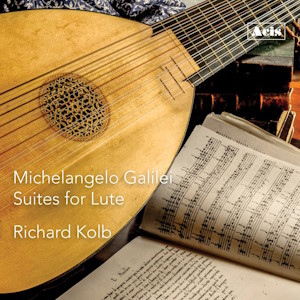
Michelangelo Galilei (1575-1631)
Suites for Lute
Richard Kolb (lute)
rec. 2024, Church of St. John the Evangelist, Tannersville, USA
Acis APL20415 [43]
What an extraordinary family! Vincenzo Galilei (1520-1591), a leading lutenist in Venice, had several sons. Most have heard of the great scientist Galileo Galilei (1564-1642) but almost no-one now recalls the precocious musical prodigy Michelangelo. Vincenzo taught the sons music very strictly, and was somewhat of a scientist, too. It seems that he was interested in what he termed ‘musical science’. He researched string tension and did a consequent study of pitch and key.
The pieces here come from Michelangelo’s Primo Libro, published in Munich in 1620 with the subtitle Varie Sonate: Come, Toccate, Gagliarde, Correnti, Volte, Passemezzi & Salterelli. Kolb’s long booklet essay tells us that they are, and should be, ‘grouped together as in the manner of Suites which was an innovation at the time’. For example, the A minor Suite begins with a Toccata, as they all do, and then has three Correntes ending in a Volta. The 1620 collection was also the first to group pieces by key. The D minor Suite’s particularly extended Toccata is followed by a Gagliarde and then a Volta.
The style of the music is, I suppose, hybrid. The music demonstrates, as noted above, a thorough grounding in Renaissance techniques such as counterpoint. But it is strongly melodic, and the composer’s father’s involvements in the early developments of monody must be an influence. There are also subtly ornamented repeats, expected of a player at the time. A good example is the last track, a Volta (by the way, not the rhythmically racy version one heard in England at that time). The influence of French lute-playing shows in style brisé, which essay describes as an ‘agitated fragmentation’ of the melodic outlines. The early baroque, then, is clearly felt in all of this music.
This is not the first recording of Michelangelo Galilei’s music. I have not come across it, but Kolb’s brief Performer’s Note says that ‘the same music was beautifully performed over thirty years ago on a landmark recording by Paul Beier”. A decade ago ,Anthony Bailes committed some pieces to disc (review). The release included five works by the prolific father, Vincenzo, and Michelangelo’s pieces were named sonatas rather than suites. Richard Kolb recorded some of them again. Both Bailes and Kolb play a ten-string lute. Vincenzo, it seems, preferred a six-string instrument.
Kolb allows the dance movements to segue into each other, so one cannot always tell where one is ending and one beginning. The recording is very close and immediate. The little wooden church of St. John the Evangelist, where the sessions took place, is charmingly pictured within.
It is something of a pity that less than forty-two minutes of Michelangelo Galilei’s music appears here. Kolb, an experienced and highly sensitive lutenist, has tackled the work of such composers as Robert Ballard and Barbara Strozzi. More examples of, say, pieces with ornamented repeats would have been even more welcome.
Gary Higginson
Availability: Acis
Contents
Suite in B flat Major
Suite in D minor
Suite in G minor
Suite in A minor
Passamezzo
Salterello
Suite in G major


















